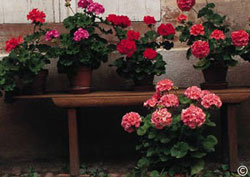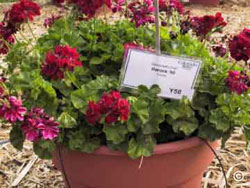What are the different types of geraniums?
There are four common categories of annual geraniums: zonal, ivy-leaf, regal and scented-leaved. Technically, the annuals referred to as geraniums belong to the genus Pelargonium. But because the genera Pelargonium and Geranium both belong to the Geraniaceae family, annual geraniums use the same common name asperennial cranesbill geraniums. Most pelargoniums, or annual geraniums, are available in shades of red, pink, purple, lavender and white.
Zonal Geraniums
Zonal geraniums (Pelargonium x hortorum) are a hybrid between P.inquinans and P. zonale. These upright geraniums’ leaf margins are often scalloped, zoned orvariegated. The leaves emit a heavy odor when bruised. Zonal geraniums can be grown from cuttings or seed.
hortorum) are a hybrid between P.inquinans and P. zonale. These upright geraniums’ leaf margins are often scalloped, zoned orvariegated. The leaves emit a heavy odor when bruised. Zonal geraniums can be grown from cuttings or seed.
Stellar Geraniums
Two recent offshoots of zonal geraniums are stellar geraniums and fancy-leaf geraniums. Stellars are essentially zonal geraniums with star-shaped flowers and finger-like leaves. Fancy-leaf geraniums are also zonals, but with leaves in unusual shapes and zones displaying bright colors.
Ivy Leafed Geraniums

Ivy-leafed geraniums (Pelargonium peltatum) feature ivy-shaped waxy leaves and a trailing growth habit that makethe plants a good choice for hanging baskets.
Regal Geraniums
Regal geraniums (Pelargonium x domesticum), also known as Martha Washington geraniums, are upright, shrubby plants whose leaves have irregular teeth and crinkled margins. The plants’ showy flowers are arranged in clusters and come in shades of pink, purple, lavender and red, often dappled with attractive markings. Regal geraniums require nights with consistently cool temperatures to produce flowers.
Scented-leaved geraniums
Scented-leaved geraniums (Pelargonium scented-leaved group), grown primarily for their aromatic foliage, often exhibit attractive flowers, as well. It’s advisable to plant these geraniums in containers, along paths and in other areas where they can be easily touched and can release their scents.
For more information, see the following Planttalk Colorado™ script(s).
For more information, see the following Planttalk Colorado™ video(s).
For more information, see the following Colorado State University Extension fact sheets(s):



